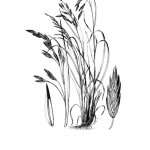Rescuegrass
Bromus catharticus Vahl (syn. Bromus unioloides)
Poaceae
Description
Rescuegrass is a bunchgrass often with fuzzy lower sheaths and blades. Its stems are robust, smooth, and unbranched. The inflorescence is erect or drooping, flat and green, turning yellow when ripe and dry. The spikelets overlap, forming Vs, and have short or no awns. The leaf collar has a papery ligule that is split on top. Grows from seed in winter and provides early forage. Matures to produce seed in early spring. Rescuegrass is an annual, cool season, introduced species reaching 18 to 36 inches or 45 to 91 cm tall. It provides fair grazing for livestock and wildlife.Habitat
Rescuegrass grows on bottomlands and can be managed as a cool-season pasture plant. It increases on overgrazed and heavily disturbed sites and is a common yard weed. Habitats include roadsides, disturbed sites, gardens, drainage lines, croplands, grasslands, open woodlands, and riparian sites. It is native to South America, but it can be found across the United States. It appears in every ecoregion of Texas.Images
Plant Characteristics
Seed Type: Non-Encapsulated
Duration: Annual, Perennial
Stem Texture: Hairless/Smooth
Growth Habit: Bunch grass, Grasses
Leaf Shape
 : Simple with Pinnate or Parallel Venation
: Simple with Pinnate or Parallel Venation
Season: Cool
Distribution
 : 01 - Pineywoods, 02 - Gulf Prairies and Marshes, 03 - Post Oak Savannah, 04 - Blackland Prairies, 05 - Cross Timbers and Prairies, 06 - South Texas Plains, 07 - Edwards Plateau, 08 - Rolling Plains, 09 - High Plains, 10 - Trans-Pecos
: 01 - Pineywoods, 02 - Gulf Prairies and Marshes, 03 - Post Oak Savannah, 04 - Blackland Prairies, 05 - Cross Timbers and Prairies, 06 - South Texas Plains, 07 - Edwards Plateau, 08 - Rolling Plains, 09 - High Plains, 10 - Trans-Pecos
Distributions
Distribution refers to the ecological region in Texas that a plant has been found. You can also view a clickable map.
Book: Know Your Grasses (B-182)
Collection: Grasses


